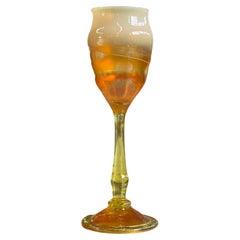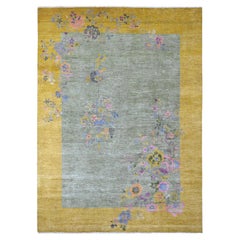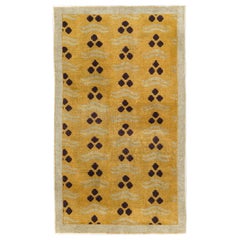Louis Comfort Tiffany Chinese and East Asian Rugs
Louis Comfort Tiffany was undoubtedly the most influential and accomplished American decorative artist in the decades that spanned the late 19th and early 20th centuries. Beyond glass, he worked in mediums that ranged from furniture and enameling to ceramics and metalware, with his Tiffany Studios producing highly collectible table lamps, vases, serveware and other objects.
The name Tiffany prompts thoughts of two things: splendid gifts in robin’s-egg blue boxes and exquisite stained glass. Charles Lewis Tiffany founded the former, and his son, Louis, is responsible for exemplars of the latter.
By the time Louis Comfort Tiffany was born, the stationery and “fancy goods” emporium his father had established 11 years before had grown to become the most fashionable jewelry and luxury items store in New York. Tiffany fils declined to join the family business and pursued a career as an artist. He studied painting with several teachers, notably the scenic painter Samuel Colman, while spending long periods touring Europe and North Africa. Though he painted his entire career, visits to continental churches sparked a passionate interest in stained glass. Tiffany began experimenting with the material and in 1875 opened a glass factory-cum-laboratory in Corona, Queens — the core of what eventually became Tiffany Studios, a multimedia decorative-arts manufactory.
Tiffany developed a method in which colors were blended together in the molten state. Recalling the Old English word fabrile, meaning “hand-wrought,” he named the blown glass Favrile, a term that signified handmade glass of unique quality. In his glass designs, Tiffany embraced the emerging Art Nouveau movement and its sinuous, naturalistic forms and motifs. The pieces won Tiffany international fame. (Siegfried Bing, the Paris entrepreneur whose design store, L’Art Nouveau, gave the stylistic movement its name, was the leading European importer of Tiffany pieces.)
By 1902, along with glass, Tiffany was designing stained-glass lamps and chandeliers as well as enameled metal vases, boxes and bowls, and items such as desk sets and candlesticks. Today such pieces epitomize the rich aesthetics of their era.
Antique Tiffany Studios table lamps are the most recognizable and the most prized. They range in price from $60,000 to upward of $2 million for intricate shade designs like the Dragonfly. Tiffany glass vases and bowls are generally priced from $1,000 to $30,000 depending on size, color, condition and form. Simpler accessories such as metal trays and small picture frames can fetch from $800 to $3,000. Tiffany design of any type is an emblem of taste and craftsmanship. As you will see on 1stDibs, Louis Comfort Tiffany ensured that each piece he and his company produced, magnificent or modest, was a work of art.
Find Louis Comfort Tiffany vases, serveware and other items on 1stDibs.
1910s American Vintage Louis Comfort Tiffany Chinese and East Asian Rugs
Glass
2010s Afghan Art Deco Louis Comfort Tiffany Chinese and East Asian Rugs
Wool
Mid-20th Century Turkish Art Deco Louis Comfort Tiffany Chinese and East Asian Rugs
Wool
Late 19th Century Chinese Khotan Antique Louis Comfort Tiffany Chinese and East Asian Rugs
Wool
1930s Unknown Chinoiserie Vintage Louis Comfort Tiffany Chinese and East Asian Rugs
Wool, Fabric
2010s Nepalese Modern Louis Comfort Tiffany Chinese and East Asian Rugs
Silk
Early 20th Century Chinese Art Deco Louis Comfort Tiffany Chinese and East Asian Rugs
Wool
Mid-20th Century Chinese Art Deco Louis Comfort Tiffany Chinese and East Asian Rugs
Wool
Mid-20th Century Chinese Art Deco Louis Comfort Tiffany Chinese and East Asian Rugs
Wool
Early 20th Century Mongolian Art Deco Louis Comfort Tiffany Chinese and East Asian Rugs
Wool
Early 17th Century Chinese Ming Antique Louis Comfort Tiffany Chinese and East Asian Rugs
Wool
Early 20th Century Chinese Mid-Century Modern Louis Comfort Tiffany Chinese and East Asian Rugs
Wool
Mid-20th Century Chinese Art Deco Louis Comfort Tiffany Chinese and East Asian Rugs
Wool
Louis Comfort Tiffany chinese and east asian rugs for sale on 1stDibs.
- 1stDibs ExpertMarch 22, 2022Yes, Louis Comfort Tiffany designed jewelry as well as glass windows, lighting and decorative objects. He helped to transform Tiffany & Co. into the luxury jewelry brand that it is today after he took control of the company in 1902. Shop a variety of Tiffany & Co. jewelry on 1stDibs.
- 1stDibs ExpertMarch 22, 2022Louis Comfort Tiffany is most famous for producing stained glass. In addition to creating windows, he used the material to create lamps and decorative objects. Tiffany also designed jewelry, and the company he led, Tiffany & Co., is now a leading name in luxury jewelry. Find a collection of Louis Comfort Tiffany furniture, art and jewelry on 1stDibs.
- 1stDibs ExpertApril 5, 2022Louis Comfort Tiffany’s favrile glass is said to be special because of the deep incandescent colors, which are reminiscent of a butterfly’s wing or a peacock’s neck. On 1stDibs, find a collection of authentic favrile glass pieces from some of the world’s top sellers.


